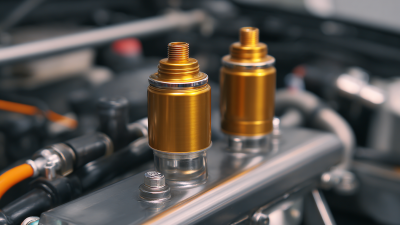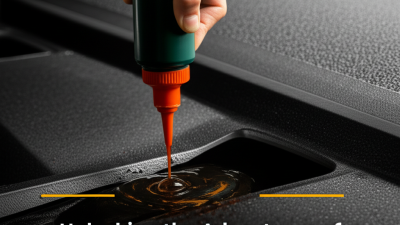How to Effectively Use Ptfe Spray Lubricant for Optimal Performance
Table of Contents
- Understanding PTFE Spray Lubricant and Its Benefits
- Preparing Surfaces Before Application for Maximum Effectiveness
- Step-by-Step Guide to Applying PTFE Spray Lubricant
- Best Practices for Maintenance After Lubrication
- Common Mistakes to Avoid When Using PTFE Spray Lubricant
- Choosing the Right ACPL-412 Compressor Lubricant for Optimal Performance and Longevity
- FAQS
- Conclusion
- Related Posts
In today's highly competitive industrial landscape, the effective use of lubricants is crucial for enhancing equipment performance and longevity. Among the various lubrication products available, PTFE Spray Lubricant stands out for its exceptional properties, including high-temperature resistance and reduced friction, making it ideal for diverse applications. According to recent industry reports, incorporating PTFE lubricants can improve machinery efficiency by up to 30%, significantly reducing wear and tear on components. At Shanghai Jiongcheng Industrial Co., Ltd., we focus on providing comprehensive lubrication solutions, including high-temperature chain lubricants and specialized products such as compressor and vacuum pump lubricants. Our advanced research and production technology, along with rigorous quality checks, ensure that our products meet the demanding needs of the industry, with PTFE Spray Lubricant being an indispensable part of our offering for optimal operational performance.

Understanding PTFE Spray Lubricant and Its Benefits
PTFE (Polytetrafluoroethylene) spray lubricant is widely recognized for its exceptional performance in reducing friction, wear, and corrosion across various applications. Its unique chemical structure allows it to form a low-friction surface, making it ideal for use in environments that require reliable lubrication under extreme conditions, such as high temperatures and pressures. According to a study by the National Lubricating Grease Institute, PTFE lubricants can reduce friction by up to 60%, significantly enhancing the lifespan of machinery and components.
To maximize the benefits of PTFE spray lubricant, it’s essential to apply it correctly. Here are a few tips: First, ensure the surface to be lubricated is clean and dry before application; this helps the PTFE bond effectively. Secondly, spray from a distance of 6 to 12 inches to achieve an even coating, preventing buildup in one area. Lastly, allow the lubricant to cure for a few minutes before using the equipment, ensuring optimal adhesion and performance.
Using PTFE spray lubricant not only enhances equipment functionality but also contributes to overall efficiency. Reports indicate that machinery downtime can be reduced by as much as 30% when appropriate lubrication is applied regularly, showcasing the importance of investing in quality lubricants for maintenance routines.
How to Effectively Use PTFE Spray Lubricant for Optimal Performance
This chart illustrates the key benefits of PTFE spray lubricant, highlighting its effectiveness in reducing friction, providing temperature resistance, and offering water and corrosion resistance, amongst other advantages.
Preparing Surfaces Before Application for Maximum Effectiveness
 Preparing surfaces before applying PTFE spray lubricant is crucial for achieving optimal performance. Start by cleaning the area thoroughly to remove dirt, grease, and other contaminants that can hinder adhesion. Using isopropyl alcohol or a degreaser, wipe down the surface to ensure it is free from any residual substances. Allow the surface to dry completely before proceeding, as moisture can interfere with the lubricant's effectiveness.
Preparing surfaces before applying PTFE spray lubricant is crucial for achieving optimal performance. Start by cleaning the area thoroughly to remove dirt, grease, and other contaminants that can hinder adhesion. Using isopropyl alcohol or a degreaser, wipe down the surface to ensure it is free from any residual substances. Allow the surface to dry completely before proceeding, as moisture can interfere with the lubricant's effectiveness.
Once the surface is clean and dry, it's essential to assess its texture. For rough surfaces, lightly sanding can improve the lubricant's grip and allow deeper penetration. On glossy or smooth surfaces, a quick scuffing can create micro-abrasions that enhance bonding. Additionally, make sure to remove any rust or old lubricant residues, as these can impact the performance of the PTFE spray. By preparing the surface diligently, you set the stage for the lubricant to work effectively, ensuring a longer-lasting and high-performing application.
Step-by-Step Guide to Applying PTFE Spray Lubricant
When applying PTFE (Polytetrafluoroethylene) spray lubricant, it's essential to follow a step-by-step approach for optimal performance. Start by ensuring that the surface to be lubricated is clean and dry. Dust, dirt, or grease can hinder the effectiveness of the lubricant. For high-performance applications, such as those involved in the operations of compressors and vacuum pumps, proper surface preparation is crucial. According to industry reports, using PTFE lubricants can enhance equipment efficiency by up to 30% due to their low friction properties and ability to withstand high temperatures.
Next, shake the PTFE spray can thoroughly before application to ensure an even distribution of the lubricant. Hold the can approximately 6-12 inches from the surface and spray in a sweeping motion, avoiding excessive application. A light coat generally suffices, as more lubricant does not always equate to better performance. Shanghai Jiongcheng Industrial Co., Ltd. emphasizes the importance of precise application in their lubrication solutions, especially in high-temperature environments seen in refrigerated compressor operations. Regular reapplication, based on operational demands, helps maintain efficient performance and prolongs the lifespan of critical machinery components.
Best Practices for Maintenance After Lubrication
Proper maintenance after using PTFE spray lubricant is essential for ensuring optimal performance of your tools and machinery. One key practice is to regularly inspect the lubricated parts. Check for any signs of wear or build-up, and make sure that the lubricant is evenly distributed. This helps identify areas that may require reapplication or additional attention. Keeping parts clean before re-lubrication is also crucial, as dirt and debris can compromise the effectiveness of the PTFE lubricant.
Tips: Always allow adequate time for the lubricant to dry after application. This minimizes residue and helps achieve a better coating on the surface. Additionally, it can be beneficial to use compressed air to blow out any excess lubricant from hard-to-reach areas, preventing it from attracting dust and grime over time.
Another best practice involves establishing a regular maintenance schedule. Depending on the usage frequency of your equipment, you should determine how often to reapply PTFE spray. Keeping a log of lubrication activities can help you track when maintenance is due and ensure that your tools remain in peak condition for longer.
Common Mistakes to Avoid When Using PTFE Spray Lubricant
When using PTFE spray lubricant, avoiding common mistakes can significantly enhance its effectiveness. One frequent error is applying too much lubricant. Overapplication can lead to a build-up that attracts dust and dirt, which can compromise the performance of machinery and components. According to industry reports, optimal lubrication often requires a thin, even coat to reduce friction while preventing residue build-up that can lead to malfunction.
Another mistake to avoid is failing to clean the surface before application. Residues of old lubricants or contaminants can interfere with the adhesion of the PTFE spray, ultimately diminishing its performance. Cleaning the intended surface thoroughly is essential; studies suggest that surfaces with less contamination yield a 30% improvement in lubrication efficacy. Additionally, many users overlook the importance of allowing the lubricant to dry completely before operating the equipment. Not doing so can lead to unintended slippage or wear on moving parts, greatly reducing the longevity of the components involved.

Choosing the Right ACPL-412 Compressor Lubricant for Optimal Performance and Longevity
When it comes to choosing the right lubricant for ACPL-412 compressors, focusing on optimal performance and longevity is crucial. With the advent of modern synthetic lubricants, poly-alpha-olefins (PAOs) have emerged as a superior choice. PAOs not only offer excellent thermal stability but also excel in low-temperature fluidity, making them perfect for various operating conditions faced by compressors. According to a recent study published by the Society of Automotive Engineers (SAE), synthetic oils like PAOs can outperform traditional mineral oils in terms of wear protection, extending equipment life by up to 50%.
In addition to their inherent properties, PAOs can be enhanced with high-performance composite additives, which further improve engine cleanliness and reduce sludge formation. These additives are designed to bolster the lubricating film, ensuring that the compressor operates smoothly under varying loads. A report from the American Society of Mechanical Engineers (ASME) highlighted that the integration of advanced composite additives can increase the efficiency of compressor systems by up to 15%, emphasizing the importance of selecting a high-quality lubricant.
Furthermore, maintaining optimal temperatures and minimizing friction is paramount for compressor longevity. Utilizing a lubricant that combines PAOs with cutting-edge additives not only enhances the operational efficiency of ACPL-412 compressors but also protects vital components, mitigating degradation due to thermal and oxidative stress. As industries increasingly lean towards synthetic solutions, the evidence points towards PAO-based lubricants as the go-to option for ensuring the reliability and extended lifespan of compressor systems.
FAQS
: PTFE spray lubricant is a lubrication product made from polytetrafluoroethylene that reduces friction, wear, and corrosion. Its benefits include forming a low-friction surface, improving machinery lifespan by reducing friction by up to 60%, and enhancing overall equipment functionality.
Surfaces should be thoroughly cleaned to remove dirt, grease, and contaminants using isopropyl alcohol or a degreaser. The area should be dried completely, and rough surfaces may benefit from light sanding or scuffing to improve lubricant adhesion.
It is recommended to spray PTFE lubricant from a distance of 6 to 12 inches away from the surface to ensure an even coating and to prevent buildup in one area.
It is advisable to allow the lubricant to cure for a few minutes before putting the equipment back into use to ensure optimal adhesion and performance.
Regular application of PTFE spray lubricant can reduce machinery downtime by as much as 30%, highlighting its importance in maintenance routines.
Yes, it is important to shake the can thoroughly before application and to spray in a sweeping motion, applying a light coat to avoid excessive buildup, as more lubricant does not necessarily guarantee better performance.
Yes, PTFE spray lubricant is suitable for high-temperature environments, such as those found in operations involving compressors and vacuum pumps, due to its ability to withstand extreme conditions.
The frequency of reapplication depends on operational demands, and regular reapplication is crucial to maintaining efficient performance and prolonging the lifespan of machinery components.
Any rust or old lubricant residues should be removed, as they can negatively impact the performance of the PTFE spray lubricant.
By reducing friction and wear, PTFE spray lubricant enhances equipment efficiency by allowing smoother operations, which can ultimately extend the lifespan of critical machinery components.
Conclusion
The article "How to Effectively Use PTFE Spray Lubricant for Optimal Performance" provides a comprehensive guide on utilizing PTFE spray lubricant to enhance equipment efficiency. It highlights the importance of understanding PTFE spray lubricant and its advantages, such as reducing friction and protecting surfaces. Preparing surfaces before application is crucial for ensuring maximum effectiveness, and the article details a step-by-step guide to applying the lubricant correctly. Best practices for maintenance post-application are also discussed to prolong the lubricant's efficacy.
Additionally, common mistakes to avoid when using PTFE spray lubricant are addressed to help users achieve the best possible results. As a leading provider of lubrication solutions, Shanghai Jiongcheng Industrial Co., Ltd. emphasizes the significance of advanced technology and quality checks in producing high-performance lubricants, including their specialized products for various industrial applications.
Related Posts
-

Understanding the Versatility of 3 In 1 PTFE Lubricant: How It Enhances Performance Across Industries
-

Unlocking Premium Quality: Discover the Best Kuvaldaru Cart Price from China's Leading Manufacturer
-

What You Need to Know About Lps 1 Lubricant and Its Unique Benefits
-

The Ultimate Guide to Craftex Dust Collector: Insights, Reviews, and Buying Tips
-

Unlocking the Advantages of Rubber Lubricant for Enhanced Performance
-

Top Strategies for Selecting the Best Reliant Dust Collector A Guide for Global Buyers
Blog Tags:

